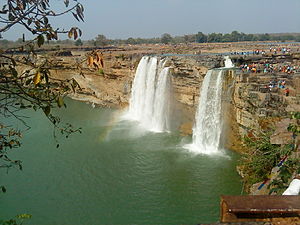| Indravati | |
|---|---|
 Chitrakoot Falls on the Indravati | |
 Indravati River watershed (Interactive map) | |
| Location | |
| Country | India |
| State | Odisha, Chhattisgarh, Telangana, Maharashtra. |
| Physical characteristics | |
| Source | |
| • location | Dandakaranya Range, Kalahandi, Odisha, India |
| • coordinates | 19°26′46″N 83°07′10″E / 19.44611°N 83.11944°E |
| • elevation | 914 m (2,999 ft) |
| Mouth | Godavari River |
• location | Somnoor Sangam, Sironcha, Gadchiroli, Maharashtra, India |
• coordinates | 18°43′25″N 80°16′19″E / 18.72361°N 80.27194°E |
• elevation | 82.3 m (270 ft) |
| Length | 264 km (164 mi) |
| Basin size | 40,625 km2 (15,685 sq mi) |
| Basin features | |
| Tributaries | |
| • left | Nandiraj River |
| • right | Bhaskel River, Narangi River, Nimbra River, Kotri River, Bandia River |
Indravati River is a tributary of the Godavari River, in central India.
The Indravati River is a stream of the river Godavari. Its starting point, found to be the Ghats of Dandakaranya, ranges from a hilltop village Mardiguda of Thuamula Rampur Block in the Kalahandi district of the state of Odisha. Due to the amalgamation of three streams, the River follows a westerly path and enters Jagadalpur in the state of Chhattisgarh. The river moves from here in a southern route, before eventually uniting with the Godavari at the borders of three states. They are the states of Chhattisgarh, Maharashtra and Telangana. The river at a variety of stages of its course forms the boundary between Chhattisgarh and Maharashtra. The river Indravati is also known as the oxygen of the Bastar district of the state of Chhattisgarh. This district is one of the greenest and eco-friendly districts, found in the whole of India. A total number of five hydroelectric projects were planned on the river Indravati. They were namely the Kutru I, the Kutro II, the Nugru I, Nugru II and the Bhopalpatnam. However, the plan misfired and did not see the light of the day due to ecological reasons. The Indravati is sometimes known as the "lifeline" of the Kalahandi, Nabarangapur, of Odisha & Bastar districts of Chhattisgarh, one of the greenest districts in India.
Most of the river's course is through the dense forests of Nabarangapur & Bastar. The river flows for 535 kilometres (332 mi) and has a drainage area of 41,665 square kilometres (16,087 sq mi).